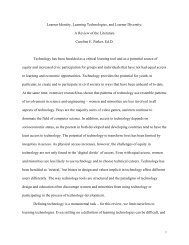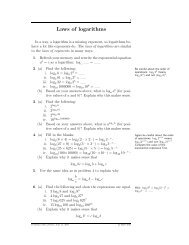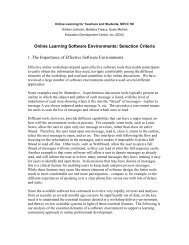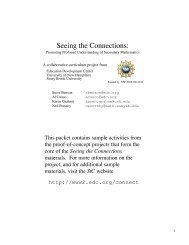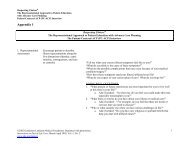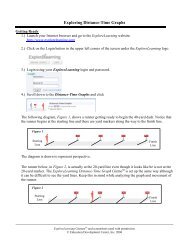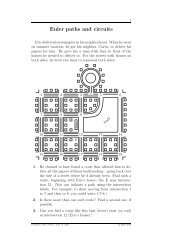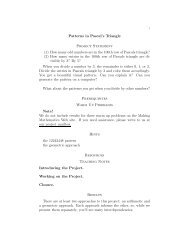School Health Program News - Education Development Center
School Health Program News - Education Development Center
School Health Program News - Education Development Center
Create successful ePaper yourself
Turn your PDF publications into a flip-book with our unique Google optimized e-Paper software.
DASH Staff <strong>News</strong>DASH’s Research ApplicationBranch has hired Mary McKenna,PhD, to serve as its lead scientificadvisor on nutrition, obesity, and initiativesto promote healthy eating.Dr. McKenna also will serve asDASH’s primary liaison to CDC’sDivision of Nutrition and PhysicalActivity and the U.S. Department ofAgriculture. Dr. McKenna joinsCDC from the University of NewBrunswick, Canada, where shetaught Nutrition and <strong>Health</strong> Promotionin the Faculty of <strong>Education</strong> for16 years. In addition, she conductedschool-based research on nutritionpolicy and health promotion, andworked to promote healthy eatingat the local, provincial, and nationallevels, with a focus on school policies.She was a technical advisor toCDC in the development of the<strong>School</strong> <strong>Health</strong> Index, and has conductedresearch on the implementationof the <strong>School</strong> <strong>Health</strong> Indexin New Brunswick schools. Dr.McKenna has a BSc in Food Sciencefrom McGill University, Canada, anMSc in Nutrition from Cornell University,and a PhD in <strong>Education</strong> fromthe University of Nottingham, England.She is a member of Dietitiansof Canada and the Society for Nutrition<strong>Education</strong>.Stacey Mattison, MPH, CHES, hasbeen asked to serve as Acting TeamLeader for the <strong>School</strong> <strong>Program</strong>Team, effective January 2003. Shewill work with the DASH managementteam to provide leadershipand guidance in the conduct oflong- and short-range assignmentsand will continue to oversee the contractwith the Rocky Mountain <strong>Center</strong>.Leah Lasco, a <strong>Health</strong> Services Officerwith the United States Public<strong>Health</strong> Service CommissionerCorps, will serve as project officerfor many of Ms. Mattison’s projects.Pete Hunt, Team Leader for the<strong>School</strong> <strong>Program</strong> Section for 10 years,has moved to the Research ApplicationBranch.DASH Improves Youth2001 OnlineDASH has released an enhancedYouth 2001 Online, its online YRBSdata query system:• Site navigation has been improvedby clarifying the wordingon links.• The options available for varioustypes of graphs are easier to use.• Comparison reports now use amore sensitive measure to determinestatistical differences overtime or between sites.These changes were made in responseto the User Satisfaction Survey.Youth 2001 Online can be accessed atwww.cdc.gov/yrbss.For more information, contact:Steve KinchenPhone: (770) 488-6161E-Mail: sak1@cdc.govCDC PublishesSARS GuidanceCDC has issued guidance for schoolson how to deal with students whohave been exposed to severe acuterespiratory syndrome (SARS).CDC’s guidance can be downloadedfrom www.cdc.gov/ncidod/sars/exposurestudents.htm.May 2003To date, all reported patients withSARS in the United States (approximately200) have been exposed eitherthrough previous foreign travelto countries with community transmissionof SARS or through closecontact with an infected person(e.g., a household member orhealth care worker). Casual contactwith a SARS patient at schools, otherinstitutions, or public gatherings(e.g., while attending the same classor public gathering) has not resultedin reported transmission inthe United States. However, managementof students who have beenexposed is a concern for manyschools.Symptoms of SARSIn general, SARS begins with a fevergreater than 100.4°F (>38.0°C).Other symptoms may include headache,an overall feeling of discomfort,and body aches. Some peoplealso experience mild respiratorysymptoms. After two to seven days,SARS patients may develop a drycough and have trouble breathing.Possible Cause of SARSScientists at CDC and other laboratorieshave detected a previouslyunrecognized coronavirus in patientswith SARS. The newcoronavirus is currently believed tobe the cause of SARS; however,other viruses are still under investigation.CDC RecommendationsPeople who have been exposed toSARS should consult a health careprovider if they develop any symptoms(i.e., fever greater than 100.4°F[>38.0°C] accompanied by a coughand/or difficulty breathing). Tohelp health care providers make adiagnosis, tell them about any recenttravel to places where SARS hasbeen reported or any contact withsomeone with SARS symptoms.11



